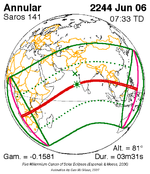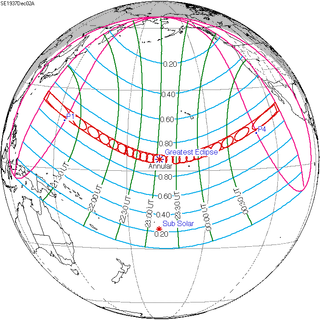Solar eclipse of December 2, 1937
| Solar eclipse of December 2, 1937 | |
|---|---|
| Type of eclipse | |
| Nature | Annular |
| Gamma | 0.4389 |
| Magnitude | 0.9184 |
| Maximum eclipse | |
| Duration | 720 s (12 min 0 s) |
| Coordinates | 4°00′N 167°48′W / 4°N 167.8°W |
| Max. width of band | 344 km (214 mi) |
| Times (UTC) | |
| Greatest eclipse | 23:05:45 |
| References | |
| Saros | 141 (19 of 70) |
| Catalog # (SE5000) | 9370 |
An annular solar eclipse occurred on December 2, 1937. A solar eclipse occurs when the Moon passes between Earth and the Sun, thereby totally or partly obscuring the image of the Sun for a viewer on Earth. An annular solar eclipse occurs when the Moon's apparent diameter is smaller than the Sun's, blocking most of the Sun's light and causing the Sun to look like an annulus (ring). An annular eclipse appears as a partial eclipse over a region of the Earth thousands of kilometres wide.
Related eclipses
Solar eclipses 1935-1938
This eclipse is a member of a semester series. An eclipse in a semester series of solar eclipses repeats approximately every 177 days and 4 hours (a semester) at alternating nodes of the Moon's orbit.[1]
| Solar eclipse series sets from 1935 to 1938 | ||||
|---|---|---|---|---|
| Ascending node | Descending node | |||
| 111 | January 5, 1935 Partial |
116 | June 30, 1935 Partial | |
| 121 | December 25, 1935 Annular |
126 | June 19, 1936 Total | |
| 131 | December 13, 1936 Annular |
136 | June 8, 1937 Total | |
| 141 | December 2, 1937 Annular |
146 | May 29, 1938 Total | |
| 151 | November 21, 1938 Partial | |||
Saros 141
Solar saros 141, repeating every about 18 years, 11 days, and 8 hours, contains 70 events. The series started with partial solar eclipse on May 19, 1613. It contains 41 annular eclipses from August 4, 1739, to October 14, 2460. There are no total eclipses in this series. The series ends at member 70 as a partial eclipse on June 13, 2857. The longest annular eclipse occurred on December 14, 1955, with maximum duration of annularity at 12 minutes and 9 seconds. All eclipses in this series occur at the Moon’s ascending node.[2]
| Series members 17–36 occur between 1901 and 2259 | ||
|---|---|---|
| 17 | 18 | 19 |
 November 11, 1901 |
 November 22, 1919 |
 December 2, 1937 |
| 20 | 21 | 22 |
 December 14, 1955 |
 December 24, 1973 |
 January 4, 1992 |
| 23 | 24 | 25 |
 January 15, 2010 |
 January 26, 2028 |
 February 5, 2046 |
| 26 | 27 | 28 |
 February 17, 2064 |
 February 27, 2082 |
 March 10, 2100 |
| 29 | 30 | 31 |
 March 22, 2118 |
 April 1, 2136 |
 April 12, 2154 |
| 32 | 33 | 34 |
 April 23, 2172 |
 May 4, 2190 |
 May 15, 2208 |
| 35 | 36 | |
 May 27, 2226 |
 June 6, 2244 | |
Notes
- ^ van Gent, R.H. "Solar- and Lunar-Eclipse Predictions from Antiquity to the Present". A Catalogue of Eclipse Cycles. Utrecht University. Retrieved 6 October 2018.
- ^ Saros Series Catalog of Solar Eclipses NASA Eclipse Web Site.
References
- Earth visibility chart and eclipse statistics Eclipse Predictions by Fred Espenak, NASA/GSFC
External links




